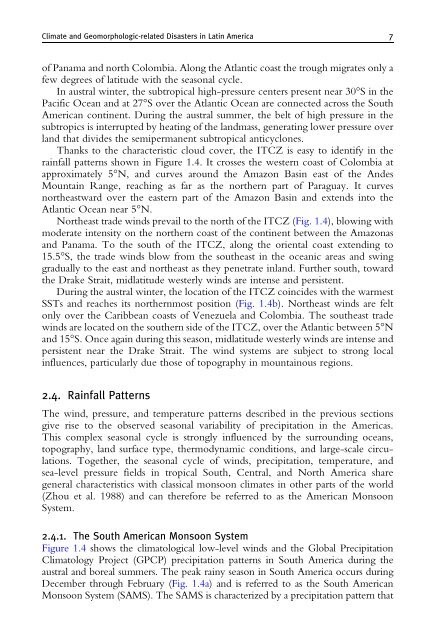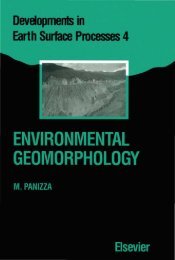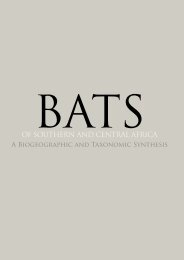- Page 2 and 3: DEVELOPMENTS IN EARTH SURFACE PROCE
- Page 4 and 5: Elsevier Radarweg 29, PO Box 211, 1
- Page 6 and 7: xiv Editorial Foreword In the first
- Page 8 and 9: xvi Foreword for natural disaster m
- Page 10 and 11: xviii Preface Disasters, which was
- Page 12 and 13: LIST oF CONTRIBUTORS Ana Luiza Coel
- Page 14 and 15: List of Contributors xxiii Jorge Ra
- Page 16 and 17: CHAPTER 1 Climate and Geomorphologi
- Page 18 and 19: Climate and Geomorphologic-related
- Page 20 and 21: Climate and Geomorphologic-related
- Page 24 and 25: Climate and Geomorphologic-related
- Page 26 and 27: Climate and Geomorphologic-related
- Page 28 and 29: Climate and Geomorphologic-related
- Page 30 and 31: Climate and Geomorphologic-related
- Page 32 and 33: Climate and Geomorphologic-related
- Page 34 and 35: Climate and Geomorphologic-related
- Page 36 and 37: Climate and Geomorphologic-related
- Page 38 and 39: Climate and Geomorphologic-related
- Page 40 and 41: Climate and Geomorphologic-related
- Page 42 and 43: Climate and Geomorphologic-related
- Page 44 and 45: 30 Carlos H. Costa et al. 1. Introd
- Page 46 and 47: 32 Carlos H. Costa et al. Some case
- Page 48 and 49: 34 Carlos H. Costa et al. to modera
- Page 50 and 51: 36 Carlos H. Costa et al. active de
- Page 52 and 53: 38 Carlos H. Costa et al. they can
- Page 54 and 55: 40 Carlos H. Costa et al. Figure 2.
- Page 56 and 57: 42 Carlos H. Costa et al. Figure 2.
- Page 58 and 59: 44 Carlos H. Costa et al. . . . . L
- Page 60 and 61: 46 Carlos H. Costa et al. Figure 2.
- Page 62 and 63: CHAPTER 3 The Changing Coastlines o
- Page 64 and 65: The Changing Coastlines of South Am
- Page 66 and 67: The Changing Coastlines of South Am
- Page 68 and 69: The Changing Coastlines of South Am
- Page 70 and 71: The Changing Coastlines of South Am
- Page 72 and 73:
The Changing Coastlines of South Am
- Page 74 and 75:
Table 3.1 Historically Known Transo
- Page 76 and 77:
The Changing Coastlines of South Am
- Page 78 and 79:
The Changing Coastlines of South Am
- Page 80 and 81:
The Changing Coastlines of South Am
- Page 82 and 83:
The Changing Coastlines of South Am
- Page 84 and 85:
The Changing Coastlines of South Am
- Page 86 and 87:
The Changing Coastlines of South Am
- Page 88 and 89:
76 Irasema Alcántara-Ayala 2003).
- Page 90 and 91:
Table 4.1 Baseline Data for Mexico
- Page 92 and 93:
80 Irasema Alcántara-Ayala Figure
- Page 94 and 95:
82 Irasema Alcántara-Ayala Figure
- Page 96 and 97:
Table 4.2 The Aftermath of Disaster
- Page 98 and 99:
86 Irasema Alcántara-Ayala People
- Page 100 and 101:
88 Irasema Alcántara-Ayala Table 4
- Page 102 and 103:
90 Irasema Alcántara-Ayala In Taba
- Page 104 and 105:
92 Irasema Alcántara-Ayala periods
- Page 106 and 107:
94 Irasema Alcántara-Ayala Figure
- Page 108 and 109:
96 Irasema Alcántara-Ayala Salvado
- Page 110 and 111:
CHAPTER 5 Venezuela: The Constructi
- Page 112 and 113:
Venezuela: The Construction of Vuln
- Page 114 and 115:
Venezuela: The Construction of Vuln
- Page 116 and 117:
Venezuela: The Construction of Vuln
- Page 118 and 119:
Venezuela: The Construction of Vuln
- Page 120 and 121:
Venezuela: The Construction of Vuln
- Page 122 and 123:
Venezuela: The Construction of Vuln
- Page 124 and 125:
Table 5.1 Vulnerability and Perform
- Page 126 and 127:
CHAPTER 6 Natural Hazards and Human
- Page 128 and 129:
Natural Hazards and Human-Induced D
- Page 130 and 131:
Natural Hazards and Human-Induced D
- Page 132 and 133:
Natural Hazards and Human-Induced D
- Page 134 and 135:
Natural Hazards and Human-Induced D
- Page 136 and 137:
Natural Hazards and Human-Induced D
- Page 138 and 139:
Natural Hazards and Human-Induced D
- Page 140 and 141:
Natural Hazards and Human-Induced D
- Page 142 and 143:
132 Michel Hermelin and Natalia Hoy
- Page 144 and 145:
Table 7.1 Summary of Selected Convu
- Page 146 and 147:
136 Michel Hermelin and Natalia Hoy
- Page 148 and 149:
138 Michel Hermelin and Natalia Hoy
- Page 150 and 151:
140 Michel Hermelin and Natalia Hoy
- Page 152 and 153:
142 Michel Hermelin and Natalia Hoy
- Page 154 and 155:
144 Michel Hermelin and Natalia Hoy
- Page 156 and 157:
146 Michel Hermelin and Natalia Hoy
- Page 158 and 159:
148 Michel Hermelin and Natalia Hoy
- Page 160 and 161:
150 Fausto O. Sarmiento the shadow
- Page 162 and 163:
152 Fausto O. Sarmiento Maquipucuna
- Page 164 and 165:
154 Fausto O. Sarmiento Table 8.2 S
- Page 166 and 167:
156 Fausto O. Sarmiento (a) Figure
- Page 168 and 169:
158 Fausto O. Sarmiento Table 8.3 S
- Page 170 and 171:
160 Fausto O. Sarmiento meant to fa
- Page 172 and 173:
Table 8.4 Adapted Summary Table of
- Page 174 and 175:
CHAPTER 9 Natural Hazards in Peru:
- Page 176 and 177:
Natural Hazards in Peru: Causation
- Page 178 and 179:
Natural Hazards in Peru: Causation
- Page 180 and 181:
Natural Hazards in Peru: Causation
- Page 182 and 183:
Natural Hazards in Peru: Causation
- Page 184 and 185:
Natural Hazards in Peru: Causation
- Page 186 and 187:
Natural Hazards in Peru: Causation
- Page 188 and 189:
Natural Hazards in Peru: Causation
- Page 190 and 191:
CHAPTER 10 Geomorphology of Natural
- Page 192 and 193:
Geomorphology of Natural Hazards an
- Page 194 and 195:
Geomorphology of Natural Hazards an
- Page 196 and 197:
Geomorphology of Natural Hazards an
- Page 198 and 199:
Geomorphology of Natural Hazards an
- Page 200 and 201:
Geomorphology of Natural Hazards an
- Page 202 and 203:
Geomorphology of Natural Hazards an
- Page 204 and 205:
CHAPTER 11 Soil Erosion in Brazil f
- Page 206 and 207:
Soil Erosion in Brazil from Coffee
- Page 208 and 209:
Soil Erosion in Brazil from Coffee
- Page 210 and 211:
Soil Erosion in Brazil from Coffee
- Page 212 and 213:
Soil Erosion in Brazil from Coffee
- Page 214 and 215:
8° 0° 8° 16° 24° 32° 40° 48
- Page 216 and 217:
Table 11.3 Soil Loss Caused by Eros
- Page 218 and 219:
Soil Erosion in Brazil from Coffee
- Page 220 and 221:
Soil Erosion in Brazil from Coffee
- Page 222 and 223:
Soil Erosion in Brazil from Coffee
- Page 224 and 225:
Soil Erosion in Brazil from Coffee
- Page 226 and 227:
Soil Erosion in Brazil from Coffee
- Page 228 and 229:
Soil Erosion in Brazil from Coffee
- Page 230 and 231:
Soil Erosion in Brazil from Coffee
- Page 232 and 233:
224 Ana Luiza Coelho -Netto et al.
- Page 234 and 235:
226 Ana Luiza Coelho -Netto et al.
- Page 236 and 237:
228 Ana Luiza Coelho -Netto et al.
- Page 238 and 239:
230 Ana Luiza Coelho -Netto et al.
- Page 240 and 241:
232 Ana Luiza Coelho -Netto et al.
- Page 242 and 243:
234 Ana Luiza Coelho -Netto et al.
- Page 244 and 245:
236 Ana Luiza Coelho -Netto et al.
- Page 246 and 247:
238 Ana Luiza Coelho -Netto et al.
- Page 248 and 249:
240 Ana Luiza Coelho -Netto et al.
- Page 250 and 251:
242 Ana Luiza Coelho -Netto et al.
- Page 252 and 253:
CHAPTER 13 Floods in Urban Areas of
- Page 254 and 255:
Floods in Urban Areas of Brazil 247
- Page 256 and 257:
Floods in Urban Areas of Brazil 249
- Page 258 and 259:
Floods in Urban Areas of Brazil 251
- Page 260 and 261:
Floods in Urban Areas of Brazil 253
- Page 262 and 263:
Floods in Urban Areas of Brazil 255
- Page 264 and 265:
Floods in Urban Areas of Brazil 257
- Page 266 and 267:
Floods in Urban Areas of Brazil 259
- Page 268 and 269:
Floods in Urban Areas of Brazil 261
- Page 270 and 271:
Floods in Urban Areas of Brazil 263
- Page 272 and 273:
Floods in Urban Areas of Brazil 265
- Page 274 and 275:
CHAPTER 14 Seismic and Volcanic Haz
- Page 276 and 277:
Seismic and Volcanic Hazards in Arg
- Page 278 and 279:
Seismic and Volcanic Hazards in Arg
- Page 280 and 281:
Seismic and Volcanic Hazards in Arg
- Page 282 and 283:
Seismic and Volcanic Hazards in Arg
- Page 284 and 285:
Seismic and Volcanic Hazards in Arg
- Page 286 and 287:
Table 14.1 Historical Earthquakes o
- Page 288 and 289:
Table 14.2 Historical Earthquakes o
- Page 290 and 291:
Seismic and Volcanic Hazards in Arg
- Page 292 and 293:
Seismic and Volcanic Hazards in Arg
- Page 294 and 295:
Seismic and Volcanic Hazards in Arg
- Page 296 and 297:
Seismic and Volcanic Hazards in Arg
- Page 298 and 299:
Table 14.4 Active volcanoes of the
- Page 300 and 301:
Seismic and Volcanic Hazards in Arg
- Page 302 and 303:
Table 14.5 (Continued) Volcano SL W
- Page 304 and 305:
Seismic and Volcanic Hazards in Arg
- Page 306 and 307:
Seismic and Volcanic Hazards in Arg
- Page 308 and 309:
CHAPTER 15 Landslide Processes in A
- Page 310 and 311:
Landslide Processes in Argentina 30
- Page 312 and 313:
Table 15.2 Population values of the
- Page 314 and 315:
Landslide Processes in Argentina 30
- Page 316 and 317:
Landslide Processes in Argentina 30
- Page 318 and 319:
Landslide Processes in Argentina 31
- Page 320 and 321:
Landslide Processes in Argentina 31
- Page 322 and 323:
Landslide Processes in Argentina 31
- Page 324 and 325:
Landslide Processes in Argentina 31
- Page 326 and 327:
Landslide Processes in Argentina 31
- Page 328 and 329:
Landslide Processes in Argentina 32
- Page 330 and 331:
Landslide Processes in Argentina 32
- Page 332 and 333:
Landslide Processes in Argentina 32
- Page 334 and 335:
Landslide Processes in Argentina 32
- Page 336 and 337:
Landslide Processes in Argentina 32
- Page 338 and 339:
Landslide Processes in Argentina 33
- Page 340 and 341:
CHAPTER 16 Floods in Argentina Edga
- Page 342 and 343:
Floods in Argentina 335 Figure 16.1
- Page 344 and 345:
Floods in Argentina 337 A B C Figur
- Page 346 and 347:
Floods in Argentina 339 Figure 16.3
- Page 348 and 349:
Floods in Argentina 341 intense loc
- Page 350 and 351:
Floods in Argentina 343 Figure 16.5
- Page 352 and 353:
Floods in Argentina 345 Table 16.2
- Page 354 and 355:
Floods in Argentina 347 Figure 16.7
- Page 356 and 357:
Floods in Argentina 349 these activ
- Page 358 and 359:
352 Elizabeth Mazzonia and Mirian V
- Page 360 and 361:
354 Elizabeth Mazzonia and Mirian V
- Page 362 and 363:
356 Elizabeth Mazzonia and Mirian V
- Page 364 and 365:
358 Elizabeth Mazzonia and Mirian V
- Page 366 and 367:
360 Elizabeth Mazzonia and Mirian V
- Page 368 and 369:
Table 17.1 Desertification in Patag
- Page 370 and 371:
364 Elizabeth Mazzonia and Mirian V
- Page 372 and 373:
366 Elizabeth Mazzonia and Mirian V
- Page 374 and 375:
368 Elizabeth Mazzonia and Mirian V
- Page 376 and 377:
370 Elizabeth Mazzonia and Mirian V
- Page 378 and 379:
372 Elizabeth Mazzonia and Mirian V
- Page 380 and 381:
374 Elizabeth Mazzonia and Mirian V
- Page 382 and 383:
376 Elizabeth Mazzonia and Mirian V
- Page 384 and 385:
CHAPTER 18 Geology and Geomorpholog
- Page 386 and 387:
Geology and Geomorphology of Natura
- Page 388 and 389:
Geology and Geomorphology of Natura
- Page 390 and 391:
Geology and Geomorphology of Natura
- Page 392 and 393:
Table 18.3 Hazards of Main Landslid
- Page 394 and 395:
Geology and Geomorphology of Natura
- Page 396 and 397:
Geology and Geomorphology of Natura
- Page 398 and 399:
Geology and Geomorphology of Natura
- Page 400 and 401:
Geology and Geomorphology of Natura
- Page 402 and 403:
Geology and Geomorphology of Natura
- Page 404 and 405:
Geology and Geomorphology of Natura
- Page 406 and 407:
Geology and Geomorphology of Natura
- Page 408 and 409:
Geology and Geomorphology of Natura
- Page 410 and 411:
Geology and Geomorphology of Natura
- Page 412 and 413:
Geology and Geomorphology of Natura
- Page 414 and 415:
Geology and Geomorphology of Natura
- Page 416 and 417:
Geology and Geomorphology of Natura
- Page 418 and 419:
Geology and Geomorphology of Natura
- Page 420 and 421:
416 Jorge Rabassa and the Antarctic
- Page 422 and 423:
418 Jorge Rabassa between 1650 and
- Page 424 and 425:
420 Jorge Rabassa 2. Climate of the
- Page 426 and 427:
422 Jorge Rabassa reservoirs, they
- Page 428 and 429:
424 Jorge Rabassa established that
- Page 430 and 431:
426 Jorge Rabassa Figure 19.5 (A) M
- Page 432 and 433:
428 Jorge Rabassa Figure 19.7 (A) M
- Page 434 and 435:
430 Jorge Rabassa Figure 19.9 The M
- Page 436 and 437:
432 Jorge Rabassa Figure 19.11 (C)
- Page 438 and 439:
434 Jorge Rabassa Figure 19.13 (A)
- Page 440 and 441:
436 Jorge Rabassa Last Glacial Maxi
- Page 442 and 443:
438 Jorge Rabassa Acknowledgments T
- Page 444 and 445:
440 Andrew S. Goudie A second facto
- Page 446 and 447:
442 Andrew S. Goudie estimates have
- Page 448 and 449:
CHAPTER 21 A Latin American Perspec
- Page 450 and 451:
A Latin American Perspective on Geo
- Page 452 and 453:
REFERENCES Ab’Saber, A.N., 2003.
- Page 454 and 455:
References 451 Atwater, B.F., Nuñe
- Page 456 and 457:
References 453 Beck, S.L., Barrient
- Page 458 and 459:
References 455 Bragagnolo, N., 1994
- Page 460 and 461:
References 457 Carr, M.J., Feigenso
- Page 462 and 463:
References 459 Coelho Netto, A.L.,
- Page 464 and 465:
References 461 De Cserna Zoltan, 19
- Page 466 and 467:
References 463 EM-DAT: The OFDA/CRE
- Page 468 and 469:
References 465 Fritz, S.C., Baker,
- Page 470 and 471:
References 467 González Díaz, E.F
- Page 472 and 473:
References 469 Hermanns, R.L.M., St
- Page 474 and 475:
References 471 Isla, F.I., 1989. Th
- Page 476 and 477:
References 473 Krepper, C.M., Garc
- Page 478 and 479:
References 475 López Bermúdez, F.
- Page 480 and 481:
References 477 Meis, M.R.M., Silva,
- Page 482 and 483:
References 479 Moura, A.D., Shukla,
- Page 484 and 485:
References 481 Pacheco, H., Suárez
- Page 486 and 487:
References 483 Plafker, G., Savage,
- Page 488 and 489:
References 485 Rodríguez, E.E., 19
- Page 490 and 491:
References 487 Schnack E.J, Pousa J
- Page 492 and 493:
References 489 Smith, K, 1996. Envi
- Page 494 and 495:
References 491 Cordillera Central C
- Page 496 and 497:
References 493 Vuille, M., Bradley,
- Page 498 and 499:
INDEX A Accelerated erosion, soil,
- Page 500 and 501:
Index 497 floods in, 257, 259-265,
- Page 502 and 503:
Index 499 CO 2 . See Carbon dioxide
- Page 504 and 505:
Index 501 E Earthquake(s) Ambato ea
- Page 506 and 507:
Index 503 Glaciers, GCC and, 420-43
- Page 508 and 509:
Index 505 global warming in, 439 IT
- Page 510 and 511:
Index 507 dry regions in, 10 squall
- Page 512 and 513:
Index 509 Tectonic plates, 32-37 Ca




